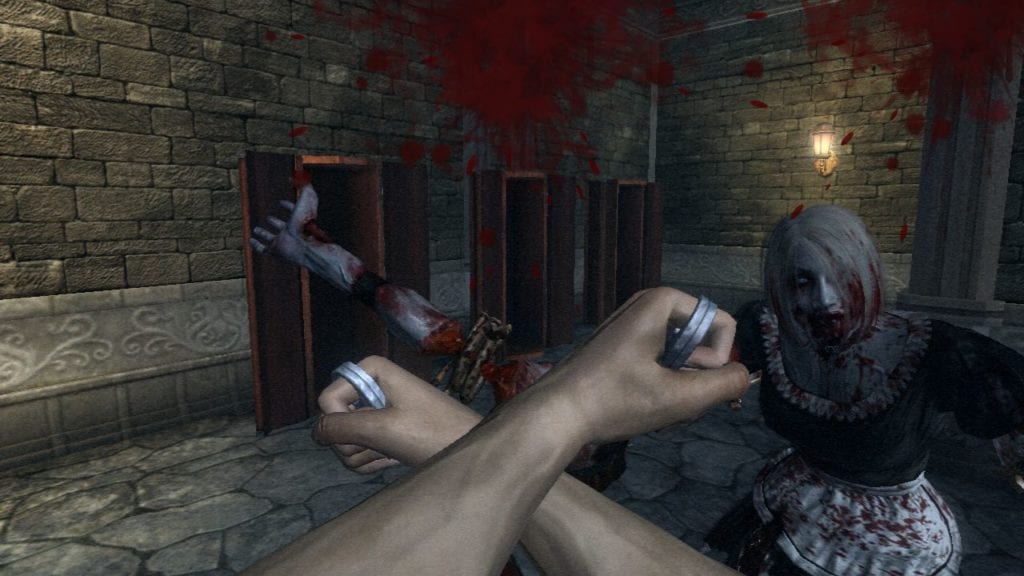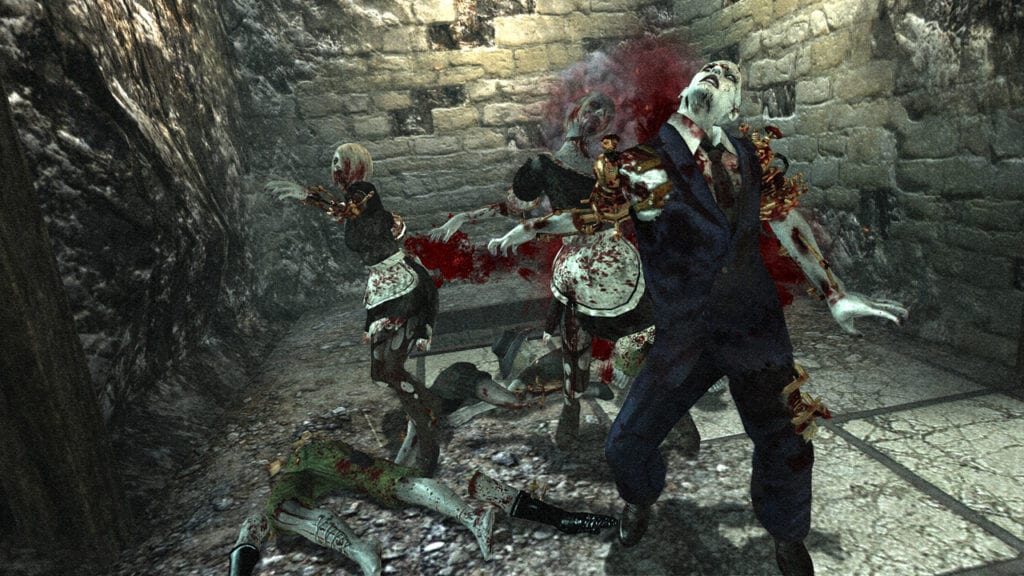For the first mainstream era of motion controls, Nintendo and Sony opted for gesture-centric hardware coupled with traditional pad controls. Microsoft went one step further, asking gamers to get up off the couch — hell, move the couch out of the room — and immerse their entire body in an interactive, controllerless world.
Unsurprisingly, people weren’t crazy about reorganizing their living room every time they wanted to play a game, and the Xbox 360’s Kinect library largely failed to fulfill its promises of immersion. The roster of Xbox 360 Kinect games were babies thrown out with the bathwater; Microsoft abandoning them at the end of the generation despite having a next-gen bath, erm, Kinect, capable of running them.
Rise of Nightmares is of these games – remaining an Xbox 360 Kinect exclusive to this day. It’s a shame, as Rise of Nightmares is not only a good Kinect game, but a decent horror adventure in its own right. It’s basic, no doubt, and without motion controls the game would be horrifically boring. But thanks to its smart use of the hardware’s capabilities, Rise of Nightmares is a horror adventure unlike any other, and one genre enthusiasts would be crazy to miss out on, so long as they don’t mind making the room to play.
European Vacation
Josh and his wife Kate are on vacation. Traveling by train through eastern Europe, Kate and Josh hope to refasten the bonds of their marriage after what is alluded to have been a rough patch. One of their marriage’s key stressors is Josh’s drinking problem. The game opens with Josh awakening from a nap in their train cabin, and Kate asking to talk with him about something important. As she begins, a flask drops from Josh’s coat pocket. Kate leaves, visibly frustrated with her husband. Josh makes chase, slowly, shuffling by other passengers as he moves through the train cars.
This section serves as something of a tutorial for the motion controls, keeping players corralled in a straight line, and asking they perform various motion-centric tasks like ducking beneath the leg of a stretching ballerina, splashing their face with cold water, and flipping tarot cards. Through his monologue and (awkward) conversations with the other passengers, Josh’s demeanor is quickly established, and it’s anything but heroic. He’s unreliable, struggling to be the husband his wife needs him to be, and a far cry from the fearless lead typical of this genre (Though it turns out he can throw one hell of a jab. See below.)
Just as Josh reaches the dining car, his planned apology hits a bit of snag. A monstrous humanoid crashes through the roof, killing everyone in his wake save for Kate. Josh looks on in horror as his unconscious wife is abducted by the monster, seconds before the train derails into a river.
Josh moves from the river, through the forest, and into the ruins of a castle. The monster, Ernst, was only one of many horrific experiments conducted in this place. Reanimated corpses equipped with metal body parts skulk the grounds, ready to ambush Josh at (literally) every turn.
Kate is seemingly just out of reach until around halfway through the game when Josh finally rescues her. Their reunification is brief, however, with Kate succumbing to the influence of a mysterious ritual. Things only get worse for Josh, and the plot moves past body horror and into – for lack of a better term – nightmare territory.
Though marketed as a tongue-in-cheek, grind-house style horror game, Rise of Nightmares is actually quite dark. Despite punching your way through hundreds of ravenous mutants, you’ll probably question whether or not this thirty-something deadbeat is up to the job. Josh has to sacrifice everything in order to get Kate back, but his sacrifice is still only half the equation. That’s not to say it’s a life-changing story, but Rise of Nightmares does a commendable job of crafting convincing and relatable characters among the backdrop of visceral action horror. Some of the game’s most memorable sequences unfold not in the heat of battle, but in the quiet and fleeting interactions with other survivors.
Josh will occasionally pair up with other survivors, though their screen-time is often short, with most of the supporting case falling victim to one of castle’s horrific traps – or worse. The horror is amplified by these short yet vivid interactions, attaching players to an NPC only to abruptly take them away minutes later. That said, there are a number of threads left dangling, and I wish the story had been flushed out just a bit more. Audio diaries scattered throughout the environments do help illuminate some of the castle’s history, though it would have been nice to have a few more of these authored by the supporting cast.

Let’s Get Physical
Rise of Nightmares unfolds almost entirely in the first-person from Josh’s point of view. There are a few segments in which you get to play as other characters, including one at the game’s start where you play as one of the ravers from the train, several hours into the crisis (one of the most memorable scenes occurs when you later replay this same sequence from a new vantage point).
Players control Josh entirely by their stance. Stand still with your hands at your side, and Josh will stand still. Rotate your shoulders and Josh will turn left or right, respectively. Take a short step forward and Josh will begin to walk. Take a long step forward and Josh will begin to jog. Likewise, stepping back will cause Josh to back up. Reaching out with your hand until a cursor becomes available on-screen, you can pick up or interact with objects of interest.
Weapons, for example, automatically equip when a player reaches out to pick them up (after a short confirmation timer hovering over the said item, ensuring the player means to pick it up). Interacting with other points, like doors or switches, prompt Josh to lock in place in front of them, requiring a secondary action of some kind to activate (pushing the door open or pulling down a switch, for example). Walls and other obstacles are slippery, and players will rarely find Josh gets stuck on anything, though he may awkwardly drag his body across the surface as he, rather topically, stumbles about the castle like a drunk.
I’m not sure whether the whole alcoholic thing was thrown in as a joke relating to how silly walking initially feels, rotating your shoulders while balancing forward in a warrior-like yoga pose, but it works. That said, if you do get tired of retreading ground, or can’t decide where to go next, raising your right hand above your head prompts the game to take control of Josh and lead him to the next objective (though you’ll still need to pause at doors and blockades to perform the requisite gesture).
Occasionally, Josh will also need to sidestep, duck, swim, or jump. These actions are situational, with the game alerting players to perform the move like a QTE. You might step into a room, only to find the doorframe booby-trapped with spikes, prompting the game to tell you to step back before the trap activates. Running in place or pretending to front crawl feel silly, but in the best way possible. There’s even one part where players have to copy the stance of a marble statue, lest Josh be burned alive if they adopt the wrong position. It’s gimmicky, sure, but moments like these keep Rise of Nightmares fresh outside of the near constant combat.

While stepping forward and turning your shoulders doesn’t sound like much of a workout, the never-ending barrage of mutants that need chopping, bludgeoning, and punching are sure to make you sweat. The core formula to each of Rise of Nightmare’s chapters usually involves exploring a handful of branching paths, collecting an item or throwing a switch, and then backtracking to the exit. These branching paths are almost always packed with obstacles, like spinning blade traps or spiked tiles – not to mention droves of the undead.
By raising your fists, Josh enters combat mode. Players can still move forward and backward, though rotating your shoulders won’t necessarily alter your course, as Josh locks onto the enemy closest to him. You can jab or kick, attempting to aim at different parts of an enemy’s body (like non-armored sections) to do more damage. Keeping your fists raised while standing still will put Josh on the defensive, with incoming (frontal) attacks being automatically blocked so long as you aren’t attempting an attack of any kind. Enemy movements and attacks are intricate and varied, and timing your strikes correctly among a crowd of mutants is the key to survival.
While it’s fun to throw out haymakers, getting greedy and dishing out too many strikes will result in Josh taking damage as enemies slip hits in. Fighting one on one is simple enough, requiring you just wait out the enemy’s telegraphed move set before letting your guard down, but when attacked by a group, combat becomes much more engaging. You’ll need to back up, lower your guard entirely, and readjust to have Josh lock onto other enemies.
While base mutants have their own weapon and attack patterns, unique enemy types will force you to alter your approach. A vocal blast from one of the opera singer mutants, for example, requires players cup their ears, being helpless to fight back until she stops to take a breath.
Fun as they are, punches and kicks don’t do much damage. Luckily, the castle is littered with all sorts of weapons, ranging from slasher cliches like baseball bats with nails in them, chainsaws, and axes, to more creative fare like test tubes filled with volatile liquid, a pump-action acid gun, and electrically-charged brass knuckles. Suffice to say, combat is a fucking hoot. Weapons degrade quickly, and you’ll need to plan your attacks accordingly, noting where weapon caches are and backtracking to re-equip yourself. Each weapon also has its own unique function, be it range, slicing, or stunning. The aforementioned electric knuckles, for example, can stall an enemy in place while you feed them 400-volt knuckle sandwiches. Axes and other bladed weapons can be swung horizontally and vertically, allowing you to dismember or disarm enemies. New weapons are introduced regularly, encouraging experimentation. While Josh’s health restores automatically when standing still, and there is no inventory management aside from weapon collection, the fact you can only carry one weapon at a time does give Rise of Nightmares some minor survival horror vibes.
You also get two special combat upgrades in the game. Though combat must always be tackled strategically, these weapon upgrades lend awesome feelings of power, allowing you to obliterate your foes with ease. They’re smartly saved for the tail end of the campaign, but are a great payoff.
All this said, Rise of Nightmare is at the mercy of the Kinect, and not everything works as it should. Not every one of your gestures, especially in combat, will be recognized by the game. Jabs can fly out rapidly, or only register sporadically. Aiming blows is almost entirely a matter of luck, and chopping or slicing horizontally versus vertically is equally unpredictable. All in all, the controls work, though you’ll have to learn to be on guard for hiccups like these, backing up while maintaining your guard after a failed attack before trying again. You’ll likely fall victim to these problems several times throughout the game, and with checkpoints few and far between, redoing long sections of combat can be demoralizing, the frustration compounded by the fact you died as a result of unregistered input.

Classical Beauty
Enemies have reactive animations, and their texturing and design matches this level of detail. The game runs at a stable frame rate, and you’ll never take damage because of a frame skip or stutter. The environments are aptly creepy, with moody lighting and fog drenching the castle grounds. It feels akin to horror out of the classic Corman or Hammer library, like The Terror – low budget, but not without charm. Despite not looking state of the art (even for its time), with NPCs lacking in detail and polygon count, and some sections of the castle being little more than empty corridors, Rise of Nightmares still feels like a fully realized production. The sound design is great, with the voice actors all doing fine jobs in their respective rolls. The gurgling, sickening growls of the mutants is unsettling, and the cacophony of screams and grunts in combat bring the action to life.
Conclusion
Rise of Nightmares is about as good as a Kinect action game could be, and it’s the sole reason I still have mine hooked up. If you could play the game with a controller, it would be harder to sing such praises. The game is a bare bones brawler, largely propped up by the fact you actually have to walk (or rather, balance and twist) your way through the environments. The combat is serviceable, though it’s only as fun as it is because of the motion controls. I wish the plot had been a bit more developed, as it builds a great foundation for a deeper, more emotionally involving story. That said, with the game running about seven hours long, it may have been too much to ask the average player to stand still for any more exposition than is already present.
Though I enjoyed this game at launch, it’s in light of modern motion and immersive gameplay experiences, like VR, that I have come to appreciate how well-designed it truly is. There are handicaps that couldn’t be avoided, but Sega did a great job of making motion control lemonade out of motion control lemons. Rise of Nightmares isn’t for everyone, but horror fans who aren’t afraid of breaking a sweat will likely be surprised at how functional, and fun, the game is. It hooks you in with its engaging (if undercooked) story, satisfying (if sometimes inaccurate) combat, silly (but fun) motion controls, and immersive (if somewhat cliché) art direction. It’s gimmicky, sure, but once you get the hang of rolling your shoulders and putting up your dukes, it’s undeniably fun.
Rise of Nightmares Summary
If the cocktail of horror and exercise sounds appealing to you (or the cocktail of exercise, horror, and cocktails for that matter), Rise of Nightmares won’t disappoint.
PROS:
- Involving story with likeable characters
- Great combat, with a huge assortment of weapon and enemy types
- Varied, silly, and fun motion controls.
CONS:
- Motion controls don’t always register as they should
- Infrequent checkpoints
- Some dated looking character models and level architecture.


